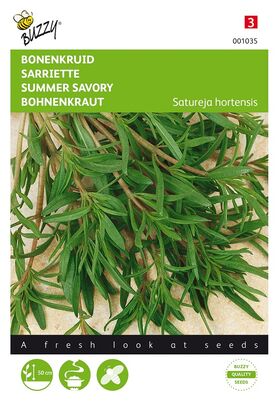Description
Savory is an everyday plant. Savory is a popular plant for bees, but also in our kitchen used a lot. Stews, pork, veal,... Read more
Savory is an everyday plant. Savory is a popular plant for bees, but also in our kitchen used a lot. Stews, pork, veal, rabbit and turkey with savory taste more delicious. With the herb seeds of buzzy seeds this should be easy to grow!
Mostly used for seasoningbean-soups and disches, but also as an infusion against coughs and colds!
With these savory seeds, you cultivate a plant that is a common plant in areas around the Black Sea and the Mediterranean. This is because savory seeds need humidity and heat to grow. The herb was very popular and widely used during Roman times.
There are two main varieties of savory. The first is Satureja Hortensis, an annual species of savory, with fine, long, narrow leaves, which have a pepper-like flavour and aromatic fragrance. The second is Satureja Montana, a perennial savory, with a stronger aroma and darker leaves. Savory, as thyme and rosemary, belongs to the Labiatae family.
Savory uses in cooking
Savory is a favourite plant for bees, but it is also widely used in the kitchen. The herb can be used fresh or dried. Ragouts, pork, veal, rabbit and turkey taste better with savory. And, of course, with beans. Not only for its flavour, but also because it has a positive effect on digestion. Beans can sometimes cause nasty, odorous consequences. Savory prevents flatulence. Savory can be cooked along. It gives dishes a slightly spicy flavour and the use of salt and pepper can be reduced.
Sowing instructions
There are 2 species of savory, annual and perennial. Both varieties of savory flower from June to September. The plant likes light, permeable, fairly fertile, calcareous soil. Savory grows and tastes best when planted in sunny spots, in shade it gives less aroma. An advantage of planting savory near broad beans is that savory gives these vegetables a better flavour and keeps them from enemy number one: the black bean aphid. Annual savory can be sown indoors from April-May. Once the risk of frost has passed, the herb can be planted out in the garden at a planting distance of 20 cm. It can also be sown directly in open ground (15 to the end of May) and thinned out or transplanted after emergence. When the first night frost sets in, the plant dies.
Perennial savory can be pre-sown from April and planted out in summer at a planting distance of about 20 to 30 cm.
The plant can easily hibernate if given some shelter from severe frosts. Regular pruning is helpful for the freshness of the plant. Savory can be dried or frozen, which does not affect the flavour much. The best time of harvesting for drying or freezing is before or during the flowering period.
These are the seeds of the annual variety.




